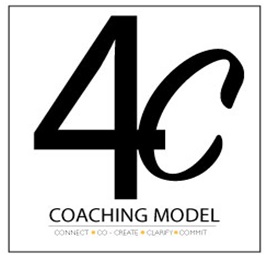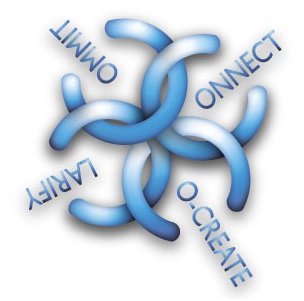A Coaching Model Created by Godfrey Kalibbala
(Life Coach, KENYA)
 The 4C model provides a coaching environment that ensures trust and openness through the Connection between the client and the coach. It ensures that there is a clear goal which is initiated by the client but Co-created by together with the coach. Building on the goal, the model provides space for exploring the realities around the goal which is defined as Clarifying; and ends with Committing which affirms the need for action and support structures.
The 4C model provides a coaching environment that ensures trust and openness through the Connection between the client and the coach. It ensures that there is a clear goal which is initiated by the client but Co-created by together with the coach. Building on the goal, the model provides space for exploring the realities around the goal which is defined as Clarifying; and ends with Committing which affirms the need for action and support structures.
Connecting:
 The coaching process begins with connection between the client and the coach. The connection between the client and the coach provides an environment of trust and openness. Bringing into the coaching space the ‘human touch’ through humor and any appropriate ice breaker provides a relaxed atmosphere for both the client and the coach.
The coaching process begins with connection between the client and the coach. The connection between the client and the coach provides an environment of trust and openness. Bringing into the coaching space the ‘human touch’ through humor and any appropriate ice breaker provides a relaxed atmosphere for both the client and the coach.
Connecting also involves setting boundaries appropriate for the coaching engagement, setting the expectations for the client and the coach, agreeing on the coaching schedule and the whole process of contracting. The way the client and coach connect sets the stage for the coaching process. This connection needs to be sustained all through. A simple question like how was your day brings a connection that may facilitate a natural flow into the coaching space.
Some of the questions to use can be: What do we need to agree on to make this coaching process a success? Internally for the coach; how can I make the coaching journey relaxing and as enjoyable as the destination? A welcome pack, Contract and exploratory engagement can be helpful for this stage.
Co-Creating:
 In the ideal, the client comes with a clear goal he/she wants to achieve. However, very often, the client’s goal is neither clearly stated by the client nor specific enough to guide the process and be able to measure progress and the outcome at the end of the engagement. In co-creating, the coach works with the client to ensure that the goal is clear to both the client and the coach; and is stated in a way that it will be possible to measure success. It is also common that in this stage the client may realize that actually what they had come up with as the goal may not be the deep rooted desire and may end up adjusting the goal. This enables the client and the coach to reconcile the expectation of the coaching engagement.
In the ideal, the client comes with a clear goal he/she wants to achieve. However, very often, the client’s goal is neither clearly stated by the client nor specific enough to guide the process and be able to measure progress and the outcome at the end of the engagement. In co-creating, the coach works with the client to ensure that the goal is clear to both the client and the coach; and is stated in a way that it will be possible to measure success. It is also common that in this stage the client may realize that actually what they had come up with as the goal may not be the deep rooted desire and may end up adjusting the goal. This enables the client and the coach to reconcile the expectation of the coaching engagement.
The key questions at this stage could be: What would you want to achieve out of this coaching engagement? What will success look like for you at the end of this coaching engagement?
The SMART goal setting tool and visualizing tools can be helpful at this stage.
Clarifying:
 A client seeks a coach because he/she wants to be supported on the journey to achieving the goal. In the client’s world, there are things that are unclear surrounding the goal as well as some things that may be hindering. At this stage, the coach works with the client to unveil the realities around the client’s goal and what could be underlying. It is a moment of exploring what is beneath the iceberg; bringing awareness and coming to the Ahaa moment. This is the moment of unveiling and supporting the client to challenge his/her own assumptions and beliefs that may be un supportive, it is a time to support the client to reframe perspective and bringing out the possibilities to his/her goal. It is the moment to support client to identify the giants in his/her way of success.
A client seeks a coach because he/she wants to be supported on the journey to achieving the goal. In the client’s world, there are things that are unclear surrounding the goal as well as some things that may be hindering. At this stage, the coach works with the client to unveil the realities around the client’s goal and what could be underlying. It is a moment of exploring what is beneath the iceberg; bringing awareness and coming to the Ahaa moment. This is the moment of unveiling and supporting the client to challenge his/her own assumptions and beliefs that may be un supportive, it is a time to support the client to reframe perspective and bringing out the possibilities to his/her goal. It is the moment to support client to identify the giants in his/her way of success.
Some key questions: What is stopping you from moving towards your goals? What behaviors /beliefs do you hold that may be standing in your way towards your goal? What options do you have to meet your goal? What is it about this goal that makes it very important to you?
Tools such as, Reframing perspective, Powerful questions, Power Listening, Mindfulness etc. can be helpful.
Committing:
 This involves eliciting the motivation and energy needed for the client to move forward towards the goal as well as defining action steps and setting structures to support him/her accordingly. Visualizing the future at this stage can be helpful in creating the energy and motivation. At this stage, Action steps are defined; and Accountability and follow up structures identified. The client is encouraged to commit to themselves and set their own structures as well as finding external accountabilities and structures around them that may be helpful to them. Structures to review progress between the coach and the client are also established.
This involves eliciting the motivation and energy needed for the client to move forward towards the goal as well as defining action steps and setting structures to support him/her accordingly. Visualizing the future at this stage can be helpful in creating the energy and motivation. At this stage, Action steps are defined; and Accountability and follow up structures identified. The client is encouraged to commit to themselves and set their own structures as well as finding external accountabilities and structures around them that may be helpful to them. Structures to review progress between the coach and the client are also established.
Some key question could be: What do you think you will look like and feel when you achieve your goal? What can you commit to do to move forward towards your goal? What structures do you have or want to put in place to support you towards your goal? How would you want me to support you in following up on your commitments?
Tools such as creating structures, visualization, Action Vs Delay etc. may be helpful.
The 4C coaching model graphic
 The graphic reflects the 4 areas of my coaching model. The 4 aspects off the model are integrated in the process of the coaching process. One does not stand independently but all contribute to each other in the coaching process. The coaching process is iterative, at each point you still need the other aspects. For examples, all through the coaching process, the aspects of connect will be needed to have an effective process, the committing will also be informed by what happened in the clarifying. They are all intertwined.
The graphic reflects the 4 areas of my coaching model. The 4 aspects off the model are integrated in the process of the coaching process. One does not stand independently but all contribute to each other in the coaching process. The coaching process is iterative, at each point you still need the other aspects. For examples, all through the coaching process, the aspects of connect will be needed to have an effective process, the committing will also be informed by what happened in the clarifying. They are all intertwined.